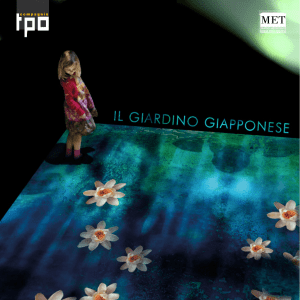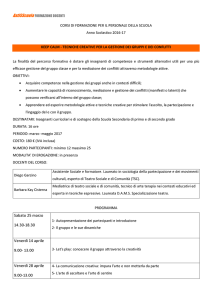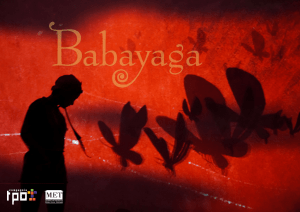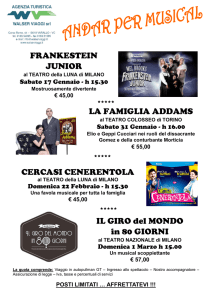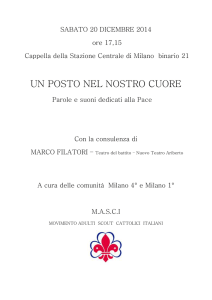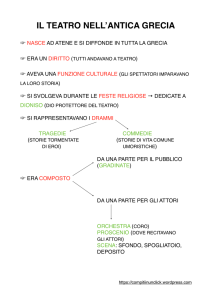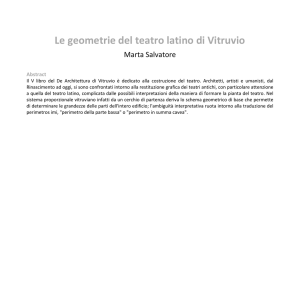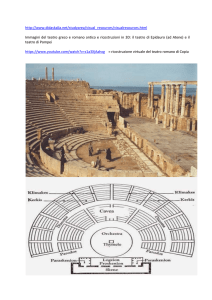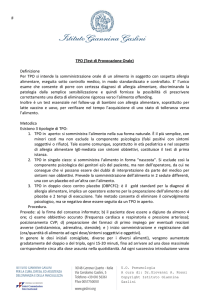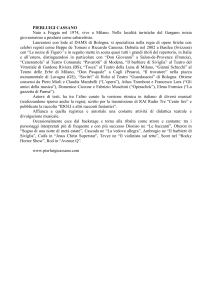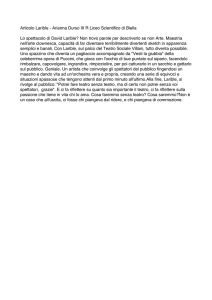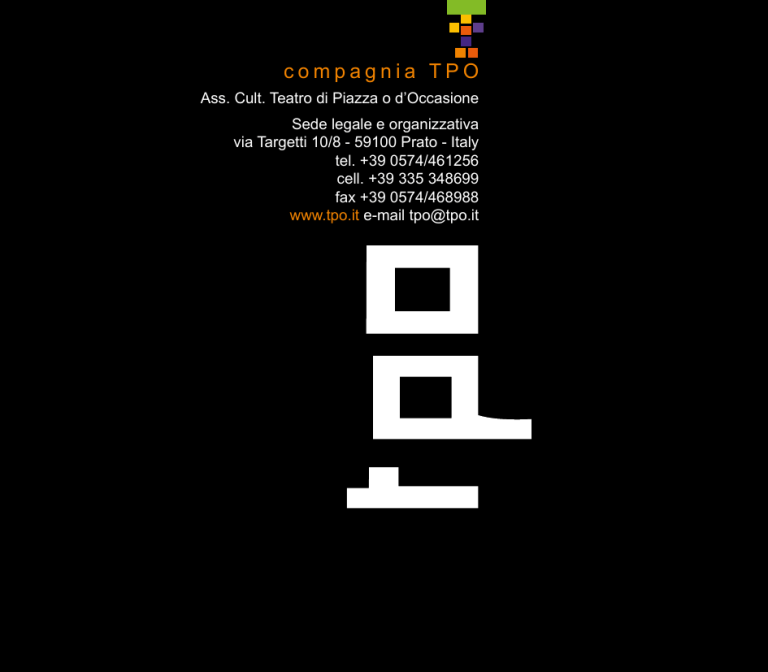
compagnia TPO
Ass. Cult. Teatro di Piazza o d’Occasione
Sede legale e organizzativa
via Targetti 10/8 - 59100 Prato - Italy
tel. +39 0574/461256
cell. +39 335 348699
fax +39 0574/468988
www.tpo.it e-mail [email protected]
C O M P A G N I A
i n t e r a c t i v e
t h e a t r e
i n
T P O
i m m e r s i v e
e n v i r o n m e n t s
Volume a cura di Compagnia TPO
Francesco Gandi, Davide Venturini (artistic direction)
Elsa Mersi (visual design)
In copertina
Foto di Davide Venturini
Nel volume
Il luogo delle immagini/The place of images Luca Farulli
Traduzione Miranda Macphail
Foto di Davide Venturini, Ilaria Costanzo
Grafica e impaginazione Elsa Mersi
3
4
5
INDICE
LA COMPAGNIA TPO......... pag. 09
SPETTACOLI A PIANTA CENTRALE.........
pag. 13
A VISIONE FRONTALE.........
pag. 51
[CHILDREN’S CHEERING CARPET]
......... pag. 75
IL TEATRO INTERATTIVO ......... pag. 91
IL LUOGO DELLE IMMAGINI di Luca Farulli 7
......... pag. 105
BACK STAGE
......... pag. 129
CURRICULUM
......... pag. 139
CONTENTS
THE TPO COMPANY ......... pag. 12
WORKS
inside BLACK BOX spaces......... pag. 13
for FRONTAL STAGE
......... pag. 51
around [CHILDREN’S CHEERING CARPET]
......... pag. 75
THE INTERACTIVE THEATER
......... pag. 95
THE PLACE OF IMAGES by Luca Farulli
......... pag. 113
BACK STAGE
......... pag. 129
CURRICULUM
......... pag. 141
8
LA COMPAGNIA TPO
T H E T P O C O M PA N Y
9
LA COMPAGNIA TPO
Teatro visivo, emozionante, immersivo: negli spettacoli del TPO il protagonista è lo
spazio scenico, le immagini, i suoni, i colori. Grazie all’uso di tecnologie interattive
ogni spettacolo si trasforma in un ambiente “sensibile” dove sperimentare il confine
sottile tra arte e gioco. Danzatori, performer e il pubblico stesso interagiscono
insieme esplorando nuove forme espressive oltre le barriere di lingua e cultura.
Il lavoro della Compagnia TPO è frutto della collaborazione di un team poliedrico e
affiatato di autori provenienti da diverse discipline delle arti visive e performative.
Gli spettacoli prodotti si caratterizzano per l’uso di proiezioni di grande formato, la
creazione di ambienti teatrali immersivi e l’impiego di tecnologie interattive alcune
delle quali specificatamente sviluppate dalla compagnia per i propri spettacoli.
Lo spazio scenico è concepito come ambiente dinamico e reattivo in grado di
coinvolgere il pubblico in azioni individuali o di gruppo: è infatti dotato di sensori
(touch pad, videocamere e microfoni), che permettono sia ai performer che al
pubblico di modulare suoni o interagire con le immagini attraverso il movimento o
la voce. Grazie a queste tecnologie vengono creati ambienti teatrali “sensibili” dove
i bambini possono esplorare lo spazio scenico e scoprire così che questo risponde
in un “certo modo” alle loro azioni; si crea quindi una relazione attiva tra loro e
l’ambiente, una forma di dialogo con spazio, forme e suoni che diventa esperienza
artistica.
Negli spettacoli del TPO il ruolo dei performer assume una valenza particolare: grazie
agli effetti interattivi “dipingono” e “suonano” in scena usando il corpo o il movimento,
ma soprattutto invitano i bambini ad esplorare lo spazio con un approccio teatrale
che privilegia l’uso del corpo e dello sguardo.
Francesco Gandi, Davide Venturini (direzione artistica)
Elsa Mersi (visual design)
Spartaco Cortesi (sound design)
Rossano Monti/Martin Von Günten (interactive engineering)
11
THE TPO COMPANY
Visual, emotional and immersive theatre. Space is the protagonist in TPO’s shows
with its images, colours and sounds. Thanks to the use of interactive technologies
every show is transformed into a ‘sensitive’ environment where the thin border
between art and play can be experienced. Dancers, performers and the audience
itself interact with each other exploring new expressive forms that go beyond
language and cultural barriers.
The work of TPO is a collaborative effort of a multi-talented and close-knit team
of authors from various disciplines of the visual and performing arts. The shows
are characterized by the use of large-format projections, the creation of immersive
theater environments and the use of interactive technologies, some of which are
specifically developed by the company for their shows.
The stage space is conceived as a dynamic and reactive environment that can involve
the public in individual or group actions: in fact it is set up with sensors (videocameras
and microphones) that allow both the performer and the public to modulate sounds
or interact with images through movement or voice. These technologies allow the
creation of ‘sensitive’ theatrical environments where children can explore the stage
space, discovering that it responds to their actions in a certain way. Thus an active
relationship ensues between the young people and their environment, a kind of
dialogue - with space, forms and sounds - which becomes artistic experience.
In the TPO’s shows even the performers’ role is imbued with special meaning: the
dancers ‘paint’ and ‘play’ on stage, using the body and movement thanks to the
interactive effects but, especially, they invite the children to explore the space with a
theatrical approach that emphasizes the use of the body and the gaze.
Francesco Gandi, Davide Venturini (artistic direction)
Elsa Mersi (visual design)
Spartaco Cortesi (sound design)
Rossano Monti/Martin Von Günten (interactive engineering)
12
works A PIANTA CENTRALE
BLACK BOX
13
pop up garden
bleu!
farfalle
play please!
saltbush
14
POP UP GARDEN
Pop up Garden è uno spettacolo dedicato
a Gilles Clement (botanico, poeta e
giardiniere) e a quei piccoli eroi che dal nulla
creano giardini nei luoghi più impensati.
E’ un invito all’osservazione delle piante,
al loro modo di danzare mosse dal vento,
al loro essere al tempo stesso generose e
capricciose.
In coproduzione con Théâtre National de Chaillot
Pop-Up Garden is a show devoted to Gilles
Clement (botanist, poet and gardener)
and to all those unsung heroes who create
gardens in the most unexpected places. It
is an invitation to observe plants and their
way of dancing in the wind, their being both
generous and mischievous all at the same
time.
22
BLEU!
Attingendo alla mitologia classica e alle
storie che il Mediterraneo porta in sé,
Bleu! narra dell’incontro tra due figure: un
marinaio e una entità magica e misteriosa,
una ninfa del mare. Tutto comincia nel
momento in cui “Lei” lascia cadere nel
mare una perla affinché “Lui” la ritrovi.
Il marinaio dovrà percorrere un viaggio
avventuroso, solcando le acque del mare e
immergersi in abissi profondi, trasformando
la nostra storia in un percorso di scoperte
e conoscenza.
Borrowing from classical mythology
and from stories that compose the very
Mediterranean area itself, Bleu! narrates
the meeting of two characters: a Sailor
and a magical and mysterious being who
is a Sea Nymph. It all starts when ‘She’
drops a pearl into the sea so that ‘He’ can
find it. The sailor will have to undertake
an adventurous journey, plowing the sea
waters and diving to the lowest abysses,
transforming the story into an active
discovery and search for knowledge.
In coproduzione con Teatro Metastasio Stabile della Toscana,
Théâtre Joliette Minoterie Marseille-Provence 2013, Capitale européenne de la culture
30
31
FARFALLE
Osserva una farfalla. Il movimento del
volo e il battere delle ali assomiglia ad un
pennello che dipinge nell’aria, ma sembra
anche una danza. Questa danza divertente
certe volte dura un solo giorno, tutto accade
dall’alba al tramonto. Ecco, guarda, c’è un
paesaggio, un uovo, una larva, un bruco,
una farfalla, tante farfalle, sono bellissime,
colorate, volano nel vento, ti sussurrano
nell’orecchio, sono ballerine che dipingono
nell’aria con le loro grandi ali.
I bambini sono invitati ad entrare e giocare
per scoprire un fenomeno affascinante
come quello della lenta metamorfosi di una
crisalide in farfalla.
In coproduzione con Teatro Metastasio Stabile della Toscana
Observe a butterfly move. The fluttering
of its wings looks as if a paintbrush were
painting on the air; but it also looks like a
dance. This delightful dance sometimes lasts
but a day. It all happens between dawn and
sunset.And now look: there is a landscape,
in it there are an egg, a larva, a caterpillar,
a butterfly, a swarm of butterflies. They are
beautiful, colourful, they flitter in the wind,
they whirr in your ear.
Two dancers move, play, paint in the air;
they are light and invite the audience
to discover a fascinating process, the
slow metamorphosis which transforms a
chrysalis into a butterfly.
38
PLAY PLEASE!
Immaginiamo di essere all’interno di un
grande strumento musicale e immaginiamo
che il nostro movimento possa creare
musica e disegni nello stesso tempo con la
semplicità di un gioco…”Play” in inglese vuol
dire tante cose: “giocare”, “suonare”, “fare
teatro”. Giocando e suonando, il grande
strumento nel quale ci troviamo diventa
una “officina di suoni”, dove tutti i bambini
sono invitati a partecipare e sperimentare
il gesto come forma di composizione,
esercizio creativo per una partitura musicale
collettiva.
In coproduzione con Teatro Metastasio Stabile della Toscana
Imagine we are inside a big musical
instrument and imagine that as we move
we can create music and drawings with the
simplicity of a game. Indeed, as we know,
we can play a game, but we can also play
an instrument or a part in a performance.
First of all, ‘play’ means ‘having fun’; and
as we have fun, the big instrument we
are in becomes a musical atelier, where
children are invited to participate and
‘experiment’ with their own gestures as a
form of composition, a creative exercise for
a collective musical score.
44
SALTBUSH
Saltbush/Atreplice è il nome di una pianta
diffusa in tutta l’Australia e rappresenta un
elemento comune a tutti i territori abitati dai
nativi aborigeni. L’atreplice rappresenta un
filo rosso che da ispirazione ad uno spettacolo
nel quale collaborano pittori, musicisti
e danzatori, narratori aborigeni e italiani.
Da questo team poliedrico di artisti nasce
uno spettacolo che rappresenta un viaggio
nel contesto mitologico australiano e nel
suo meraviglioso paesaggio naturale.
Saltbush is a plant that can be found
throughout Australia so it is a shared
element of all the lands inhabited by
Aboriginal natives. Here it is the common
thread that inspires a show created by a
collaboration among Aboriginal painters,
musicians, dancers and story-tellers who
have given rise to a journey through the
mythology of Australia and that country’s
extraordinary natural landscape.
50
works A PIANTA FRONTALE
FRONTAL STAGE
51
babayaga
kindur
v i t a av v ent ur os a d e l l e
pec or e i n I sl a n d a
barocco
52
BABAYAGA
Nella fiaba originale “Babayaga”, una
bambina è costretta ad abbandonare la
propria famiglia per andare nella casa della
terribile orchessa, ma nel suo viaggio saprà
farsi aiutare da alcuni animali ad affrontare
i pericoli. L’intuito, il coraggio e la capacità
di stringere amicizie sono le risorse per
affrontare una sfida che non si può vincere
da soli. La compagnia italiana TPO ha
messo in scena questa celebre fiaba russa
in una chiave contemporanea, usando la
danza, musiche originali e soprattutto le
sontuose illustrazioni di Rébecca Dautremer
proiettate in grande formato su tutta la
scena.
In coproduzione con Teatro Metastasio Stabile della Toscana
In the original fairytale of “Babayaga”, a
little girl is forced to leave her family home
for the house of the terrible ogress, but
on her hard journey she meets several
animals who help her brave the dangers.
Her intuition, courage and ability to make
good friends are the qualities she needs
to face a challenge that cannot be won
on her own. The Italian company TPO has
staged this well-known Russian tale in a
contemporary way, using dance, original
music compositions and especially Rébecca
Dautremer’s lavish illustrations projected in
large format across the whole stage.
60
KINDUR
v ita a v v e n tu r o s a d e ll e pec or e i n I s l anda
the adv e n tu r o u s life of I c el andi c s heep
“Kindur” in islandese significa “pecore” e
questo è uno spettacolo dedicato all’Islanda
vista attraverso gli occhi delle sue pecore
avventurose. Chiuse dentro all’ovile per
la stagione fredda, possono poi gustarsi
la piena libertà, viaggiando solitarie o a
piccoli gruppi, dalla primavera all’autunno.
Nella loro ricerca di cibo hanno modo
di immergersi nella natura più remota
e frequentarne gli abitanti “nascosti”
come i troll o gli elfi. Ci mostrano questo
mondo segreto, forte e fragile allo stesso
tempo, capace di comunicare ai bambini
la straordinaria bellezza della natura di
quest’isola.
In coproduzione con Teatro Metastasio Stabile della Toscana
In Icelandic “kindur” means “sheep” and
this show is devoted to Iceland as it is seen
through the eyes of the country’s most
adventurous flock. Enclosed in their barn
during the cold winter months, from spring
to autumn the sheep delight in the utmost
freedom, ranging alone or in small groups.
Their search for food takes them to the
most remote natural settings where they
meet such “hidden” inhabitants as trolls or
elves. The sheep show us this secret world
which is at once strong and fragile, capable
of communicating to children this island’s
extraordinary beauty.
68
BAROCCO
Una visita insolita nel castello di Vaux
le Vicomte. Due graziose ballerine
passeggiano, scherzano, giocano in stanze
apparentemente pompose e lussuose,
vagando da una stanza all’altra ci mostrano
le meraviglie di un “mondo barocco”.
In coproduzione con Teatro Metastasio Stabile della Toscana
A highly unusual visit inside the Castle
of Vaux le Vicomte. Two pretty ballerinas
stroll, joke, and play as they go from one
stately and luxurious room to another.
Through their meandering, we are able
to discover and experience first hand the
wonders of a “Baroque world.”
74
works
75
CHILDREN’S CHEERING CARPET
THE GARDEN TRILOGY
il giardino giapponese
il giardino dipinto
il giardino italiano
76
IL GIARDINO GIAPPONESE
IL GIARDINO DIPINTO
IL GIARDINO ITALIANO
IL GIARDINO ITALIANO
Il giardino all’italiana è come un sogno,
oppure un gioco segreto e misterioso.
Abbiamo voluto aprire il cancello e lasciare
che i bambini si perdano nei labirinti, nelle
grotte, nei giochi d’acqua, lungo i sentieri
segnati dalle siepi di bosso…
IL GIARDINO DIPINTO
Intorno ad un cortile di luce colorata che
ricorda un tappeto arabeggiante il pittore
curdo Rebwar Saeed ci invita ad entrare
nel suo giardino dipinto con i suoi colori
preferiti: il giallo (il giardino di terra), il blu
(il giardino d’acqua), il verde (il giardino di
foglie), il rosso (il giardino dell’amore).
89
THE ITALIAN GARDEN
The Italian garden is something like a
dream or else like a secret and enigmatic
game. Here the gates have been opened
wide, allowing the children to lose their way
in the labyrinths, inside the grottoes and
behind the water follies, as they tread the
pathways lined with boxwood hedges...
THE PAINTED GARDEN
In the courtyard of coloured light that
recalls an oriental carpet, the Kurdish artist
Rebwar Saeed invites us to enter his garden
painted with his favorite colours: yellow
(the garden of earth), blue (the garden of
water), green (the garden of leaves), and
red (the garden of love).
IL GIARDINO GIAPPONESE
Il giardino giapponese è un mondo in
miniatura ed ha origine in un racconto:
Shiro un ragazzo coraggioso, è il primo
giapponese a partire dal suo piccolo
villaggio di montagna per arrivare fino al
mare, l’oceano… Oltre non può andare.
In coproduzione con Teatro Metastasio Stabile della Toscana
THE JAPANESE GARDEN
The Japanese garden represents a miniature
world and its origins begin with a tale:
Shiro, a very brave little boy, is the first one
in Japan to leave his mountain village to
journey as far as the ocean’s shores... His
wandering cannot go beyond this border of
land and water.
90
IL TEATRO INTERATTIVO
I N T E R A C T I V E T H E AT E R
91
92
IL TPO E IL TEATRO INTERATTIVO
Il TPO crea “ambienti sensibili”, delle opere interattive di danza e teatro visivo,
concepite come spazi “immersivi”, dove si mette in atto una poetica basata sulla
relazione tra il corpo, i suoni e le immagini. Negli spettacoli il pubblico di bambini
o adulti è invitato ad esplorare la scena: qui è possibile muoversi, correre, giocare,
toccare, rotolare sopra immagini che evocano ambienti naturali o luoghi d’arte.
Lo spazio reagisce all’intero movimento del corpo; al tocco dei piedi ad esempio,
come se fosse l’appoggio del peso a guidare lo sguardo. I performer sono “guide
silenziose” che aiutano il pubblico, attraverso una comunicazione non verbale, a
superare l’imbarazzo del coinvolgimento attivo.
I performer si lasciano sorprendere dagli stimoli creati dalla macchina scenica,
giocano con i suoni e le immagini, stimolano la complicità e la curiosità spontanea
dei bambini. Lo spazio scenico diventa quindi un luogo condiviso ed è questa
condivisione che rende l’uso delle tecnologie interessante. Lo stare insieme in un
“ambiente teatrale dinamico”, piacevole, adatto al gioco e al movimento, diventa
un’esperienza che coinvolge emotivamente al di là degli aspetti tecnici o tecnologici.
Potremmo anche dire che l’uso delle tecnologie interattive avanzate, assume un
valore pedagogico ed educativo proprio perché amplifica le possibilità creative e
percettive di tutto il corpo. Sulla scena i sensori e le altre applicazioni interattive
sono volutamente nascoste, ma l’obiettivo dei nostri progetti non è quello di esaltare
l’uso delle tecnologie digitali, bensì quello di introdurre il pubblico al mondo delle arti,
quelle contemporanee in particolare. Per questo motivo prestiamo grande attenzione
alla qualità dei suoni e delle immagini, al loro valore evocativo, emotivo e poetico
cercando di sviluppare una narrazione visiva dove l’uso del colore e delle forma
possano comunicare un senso diffuso di bellezza. Nel buio, nei giochi di luce e di
colore, la bellezza della danza parla e invita a percepire questi spazi come luoghi da
93
abitare. La facilità di accesso, l’intuitività delle regole alla base di questo modo di fare
teatro sono fondamentali, il pubblico deve poter capire senza istruzioni e partecipare
senza obblighi. Quando alcuni bambini entrano in scena lo fanno quindi come
soggetto attivo, capace di agire all’interno di un quadro che si trasforma facilmente
e non richiede nessuna particolare attitudine né tanto meno una esibizione. Le
persone o i bambini disabili, ad esempio, non sono affatto inibiti dal partecipare dal
vivo ad una azione individuale o di gruppo, la macchina interattiva li accoglie e per
certi aspetti facilita loro azione proprio perché valorizza la spontaneità dei gesti.
LA SCENA DIGITALE E I PAESAGGI NATURALI
Il rapporto tra il paesaggio naturale e la sua rappresentazione virtuale è un aspetto
molto importante nel nostro lavoro. Ogni volta che affrontiamo un nuovo progetto ci
chiediamo come creare un ambiente visivo/sonoro che possa innescare un racconto.
Il lavoro di regia si concretizza poi in uno storyboard accurato, quasi cinematografico;
in questo esercizio di simulazione tutto il team lavora alla creazione degli ambienti
pensandoli come dei “paesaggi emotivi” in cui le immagini e i suoni possano “agire”
in dialogo armonico con chi è in scena. Nel gioco tra “azioni” (danza, movimento) e
“interazioni” (immagini, suoni) si creano segni che potranno essere anche astratti o
allusivi, come una scenografia animata che racconta ciò che le parole non possono
dire. In questo contesto, la rappresentazione o la finzione scenografica, che nel
teatro tradizionale hanno un ruolo importante ed un loro codice, vengono superati
privilegiando l’idea di un teatro di nuova generazione in cui l’esercizio estetico ed il
gioco con le arti diventano protagonisti.
94
TPO AND INTERACTIVE THEATRE
The TPO Company creates “sensitive environments”, interactive works involving
dance and theatre; conceived as “immersive” spaces, they are ideal places to
explore poetics based on the relationship between body, sound and images. During
the shows the audience of children or adults is invited to investigate the stage space;
here they can move, run, play, touch or even roll over the images suggesting natural
landscapes or places of art. The space, in turn, reacts to the whole movement of
the body; for instance, the pressure of feet creates the sensation that weight can
direct the gaze. Our performers are “silent guides” who, through their nonverbal
communication, help the audience get over any embarassment tied to active
participation.
The performers allow themselves to be surprised by the stimuli created by the stage
setup; they play with the sounds and images, arousing the children’s spur-of-themoment curiosity and complicity. Therefore it is the sharing of the stage space that
makes the use of technology interesting. Experiencing together a pleasing “dynamic
theatrical environment,” well-suited to play and fun, involves the viewers’ emotions
even beyond any technical or technological aspect. We might even assert that the
use of advanced interactive technologies assumes an educational value because it
amplifies the whole body’s creative and perceptive capabalities.
The stage sensors and the other interactive applications are hidden on purpose, but
this is not to exalt their effects. Rather our aim is to introduce the audience into the
world of -- especially contemporary --arts. This is why we take so much care with the
quality of the sound and images we use; we choose them for the emotion and poetry
they are capable of conjuring up. Through their use we develop visual narration in
which the use of colour and form can communicate an ample sense of beauty. In the
dark the plays of light and colour as well as the beauty of dance speak and invite
95
the audience members to perceive this space as a place to inhabit. Easy accessibility
and the intuitive rules underlying this way of doing theatre are fundamental; with
no instructions the audience has to understand and to participate without feeling
obliged. So when several children enter onstage they do so as ready and active
subjects inside an easily-transformable painting that doesn’t require any particular
skill, let alone exhibition. For example, physically-challenged audience members are
not in the least inhibited about participating live in an individual or group action. The
interactive setup welcomes them and in some cases facilitates their action because
it highlights the spontaneity of gesture.
THE DIGITAL SET AND NATURAL LANDSCAPES
A fundamental consideration in our work centers on the relationship between the
natural landscape and its virtual representation. Prior to any new project we first
ask ourselves how we can create a visual/audio environment that can trigger a tale.
From that point on the task of directing takes the form of a carefully prepared, almost
cinematographic storyboard. In this practice of simulation the entire team works on
creating emotive environments in which sounds and images can be actors playing in
harmony opposite the performers on stage. The exchange between actions (dance,
movement) and interactions (images, sounds) generate signs, which can even be
abstract or allusive, like an animated scene that narrates what words cannot say.
In such a context the representation or the stage pretense – which, in traditional
theatre, have always had an important role and a precise code – are abandoned in
order to reach an idea of new theatre: one in which the key players are aesthetic
pratice and the exercise of all the arts.
96
IL LUOGO DELLE IMMAGINI
L’uomo è il luogo delle immagini: immagini-desiderio, immagini di esperienze,
immagini che abitano la sua mente, la sua anima. La scena teatrale costituisce
lo spazio ove tali immagini prendono corpo e per un attimo, trovano il coraggio di
guadagnare la luce, di farsi oggetto vivente. La ricerca drammaturgica compiuta
da TPO in questi decenni rappresenta, in tal senso, un contributo di chiarificazione
in merito al rapporto tra immagini e scena, tra immagini e teatro nell’epoca dei
linguaggi elettronici. Il lavoro di TPO prende forma a partire da una ricerca sulla
comunicazione non verbale, un lavoro sul rapporto interattivo con le immagini che da
vita alla trilogia CCC [children’s cheering carpet]: Il giardino giapponese, Il giardino
dipinto, Il giardino italiano. CCC promuove un doppio rovesciamento: in primo luogo,
rispetto al paradigma del luogo scenico, superando i limiti della visione frontale
tipica del teatro all’italiana. Disposto negli spazi “Black Box”, ai piedi di performer
e pubblico partecipante, il tappeto sgombra, infatti, d’un colpo, ogni propensione
contemplativa, ogni veduta a distanza. In secondo luogo, il rovesciamento promosso
da TPO riguarda la dimensione dell’immagine: essa non coinvolge semplicemente la
vista e l’occhio, bensì anche il tatto, le mani i piedi e quindi tutto il corpo. Si tratta
di un rovesciamento di grande rilievo, proprio in merito all’uomo come luogo delle
immagine: sopite, latenti, desideranti, insospettate. Toccare una immagine, aprirla,
essere toccati da una immagine è, infatti, esperienza imparagonabile rispetto alla
sua percezione passiva. Azione divertita ed esplorativa, il tastare un’immagine
ha l’effetto di un sasso lanciato in acqua, l’onda si propaga e di riflesso crea un
paesaggio dinamico. Accarezzare, sfiorare con le mani o con il piede un’immagine,
suscitandone la vita ha, infatti, per suo effetto quella di attivare nel performer o nel
pubblico partecipante immagini interiori, note o dimenticate: un fare esperienza di
sé nell’esperienza dell’altro. Per questa ragione, partecipare agli spettacoli di TPO
seduti nei propri posti o, invece, in quanto soggetti attivi camminando sul tappeto
è cosa ben diversa. Importante fu, in questo senso, l’esperienza vissuta ad Halle
nella Repubblica Federale Tedesca anno 2004, nel corso di una rappresentazione de
105
Il giardino giapponese: ad un tratto, il tappeto fu invaso da un gruppo di educatori
adulti, il quale si sentì chiamato, proprio da quelle immagini che occhieggiavano sul
tappeto, a danzare-giuocare con esse, in un attimo di appagata felicità, intrecciando
storie con esse.
Il gioioso correre dietro le immagini, lo stupefatto aprire le immagini non finisce,
però, nel mero divertimento, nel mero giuoco senza resto, nel caso della trilogia
legata ai giardini, la struttura narrativa offre al fruitore un viaggio per immagini,
quello compiuto dalla voce narrante, presupposta in ognuno dei tre percorsi: Shiro,
nel giardino giapponese, il pittore Rebwar Saeed nel giardino dipinto, il poeta
Francesco Colonna nel giardino italiano. E’ questa integrazione di dimensione scenica,
drama e racconto – costituente la struttura degli spettacoli - ad evitare il precipizio
nelle immagini, a rendere la gioia della partecipazione una via di esplorazione e di
riflessione da parte dei sensi. Nel caso specifico della trilogia, il richiamo al paradigma
letterario del giardino contribuisce, inoltre, a definire ulteriormente la particolarità
del luogo teatrale: luogo circoscritto, eppur aperto, fatto di architettura e di rinvio
costante al ‘fuori’, il giardino si presenta come scenario ideale per il racconto di
viaggi; quelli compiuti e testimoniati dagli oggetti affioranti sul tappeto, quelli
immaginati e, quindi, prodotti dal desiderio. Abbiamo così due regimi di immagini:
quelle prodotte dall’immaginazione e quelle legate ad una esperienza reale, tratte
dai vagabondaggi compiuti da performer e pubblico nel mondo dell’arte, dei costumi
di donne e uomini d’altrove. Potremmo dire: un Grand Tour dell’epoca elettronica.
Dovremo tornare sul tema del viaggio, al momento vale procedere in direzione
del salto rappresentato dalla produzione della compagnia nel triennio 2008-2009:
Farfalle, e Play Please!
In queste opere la “immaginazione tecnologica”1 del gruppo è passata dalla
progettazione di spazi a quella della creazione di veri e propri ambienti; l’interattività
1 In merito al tema della immaginazione tecnologica mi sono soffermato in modo più
articolato nel corso di uno studio, a cui mi permetto di rinviare: L.Farulli, Immaginazione
tecnologica. Per un’estetica della media art, Firenze, Polistampa, 2013, in particolare pp.
5-7.
106
non è più dimensione limitata al disegnare con il corpo sul tappeto, ad attivare
immagini, bensì consente di aprire mondi, ambienti avvolgenti di azione, di entrare
nella fabula. Le cose che abitano tale ambiente, che sono date a vedere vivono in
una apparente e silenziosa dimensione di pre-vita: paiono inanimate, eppur son
contenitori di storie, oggetti vivi che si fanno interfacce verso altre dimensioni
dell’essere. Ricordano l’albero di Alice nel paese delle meraviglie il cui tronco, se
toccato, introduce ad un insolito stato delle cose. In particolare, gli oggetti di Farfalle,
riportano, in certo modo, a quella dimensione della natura di cui riferisce Socrate nel
dialogo con Fedro, nell’omonimo dialogo platonico: “Oh! Ma i preti del tempio di Zeus
a Dodona, mio caro, dicevano che le prime rivelazioni profetiche erano uscite da una
quercia. Alla gente di quei giorni, che non era sapiente come voi giovani, bastava
nella loro ingenuità udire ciò che diceva ‘la quercia e la pietra’, purché dicesse il
vero”1. In Farfalle, infatti, la natura è di genere sonoro; essa parla, nel momento
in cui lunghe aste a forma di ramo o di gigante germoglio, la toccano, la sfiorano,
mosse con gesto rituale dai danzatori. La tenda ancestrale che compare sul tappeto
diviene luogo dell’ascolto, che invita i bambini a esplorare il suono, a toccarlo con
mano, a vivere la favola dal dentro.
Ambiente, immersione: come è possibile mantenere le condizioni per una
esperienza estetica ed artistica consapevole nel contesto di una esperienza vissuta
immersivamente e dominata dallo stupore, dalla fascinazione di colori e suoni?
L’importante questione costituita dalla “immaginazione tecnologica” torna qui
a svolgere una prestazione di primo piano. Il giuoco integrato di telecamere e
sensori comandati dal software Max Msp_Jitter, favorisce, infatti, una narrazione
per immagini che procede a salti, sempre interrotta, contrassegnata, come è, dalla
comparsa, sul tappeto, di a-parte teatrali, i quali moltiplicano l’ingresso di oggetti
drammaturgici, portando il pubblico ad una tensione plurima, che diviene caccia,
inseguimento di oggetti vivi. Si viene, così, a determinare un rapimento multiplo del
cuore, una eccitazione che è, a tutti gli effetti, una partecipazione di tipo esplorativo,
1 Platone, Fedro, 275b.
107
intervallata ed interrotta da momenti di ricezione nel raccoglimento, come nel
momento in cui il singolo bambino è condotto per mano dal danzatore/danzatrice
a osservare la lenta metamorfosi di una crisalide che diviene farfalla. E’ questo
insieme di livelli che porta la rappresentazione a farsi simulazione di vita.
La “immaginazione tecnologica” che ha guidato in Farfalle l’applicazione di Max Msp_
Jitter – facendo di procedimenti nati, in origine, con finalità meramente riproduttive,
media propriamente artistici, cioè, di genere produttivo – è all’opera in un altro
spettacolo, Play Please! pur seguendo modalità tutte proprie e differenti. In questo
caso, infatti, la telecamera utilizzata non funziona a infrarossi; l’interfaccia tra corpo
del performer e processore è, in questo caso, invece, costituito dall’elemento luce
che si fa “attiva” in una accezione prossima a quella proposta da Adolphe Appia1,
dal momento che essa non si limita a sagomare una porzione di spazio scenico
od a produrre atmosfera e giuoco di ombre dimostrando, in ciò, tutta la propria
dimensione di linguaggio artistico, bensì la luce svolge un ruolo attivo, in quanto
è messaggera, verso il processore, delle azioni svolte dai corpi in scena, i quali
diventano produttori di sonorità, di immagini, di segni grafici. La definizione di luce
“attiva” proposta da Appia viene, così, recepita ed oltrepassata, in quanto essa è
vera e propria dramatis personae, personaggio e mezzo attraverso cui il mondo, si
potrebbe dire, è dipinto e suonato: essa è veicolo di produzione di una soglia di realtà
sonora e cromatica. Nello stesso lasso di tempo in cui vengono realizzati Farfalle e
Play Please! nasce il grande spettacolo di Barocco. Esiste un filo conduttore che lega
la ricerca teatrale connessa a queste tre produzioni: quello dell’ambiente/paesaggio
1 In merito al tema della luce come momento drammaturgico fondamentale, dotato di
una propria autonomia e, quindi, di una specifica valenza estetica si veda: F. Crisafulli,
Luce attiva. Questioni della luce nel teatro contemporaneo, prefazione di L. Farulli,
Corazzano, Titivillus, 2007, in particolare le pp. 33-41. Per quanto riguarda la vicinanza
della concezione sviluppata da Appia di “Luce attiva” con elementi rilevanti del lavoro di
TPO si noti questa riflessione di Appia: “La luce possiede una versalità quasi miracolosa.
Ha in sé tutti i valori della luminosità, le infinite possibilità dei colori come una tavolozza,
una straordinaria mobilità; essa può creare le ombre, può riempire lo spazio con l’armonia
delle proprie vibrazioni esattamente come la musica” (Tratto da: F.C., op. cit., p.p. 34-35).
108
visivo, attivato e perlustrato per via aptica. In Barocco, però, TPO realizza un genere
di lavoro teatrale che oltrepassa il mondo della favola e l’orizzonte d’attesa del
pubblico di bambini. L’estetica delle interfacce conduce, in Barocco, ad un diverso
esito: quello di un singolare viaggio nella visione. Ciò che è qui in giuoco, infatti, è
qualcosa di più della mera esperienza visiva nelle opere d’arte, nel mondo di specchi,
nelle feste e nelle luci che caratterizzano la cifra del Barocco. Determinante in questo
spettacolo è il modo in cui la “immaginazione tecnologica” ha sviluppato l’ottica
operazionale caratteristica dell’ambito di realtà connesso alle immagini elettroniche
interattive: in Barocco scompaiono i segni di distinzione tra alto e basso, i criteri di
orientamento tra sopra e sotto; tutto è rapito in una vertigine della visione, come
se il soggetto umano si muovesse in una realtà senza peso, priva di gravità, eterea.
L’alto ed il basso, il sopra ed il sotto non sono dati nella loro stabilita ordinarietà,
nel loro ordine paradigmatico acquisito, bensì vanno stabiliti e, sempre di nuovo,
fissati, esperiti. Ancora una volta, però, il precipizio nel mero giuoco percettivo
è raffreddato dalla presenza di un inserto “epico”, narrativo: il M.I.A. Mechanical
Interactive Actor pilotato sempre dal citato Max/Mps, funge da voce narrante, da
rapsodo, contribuendo a raffreddare i sensi, a farli, per così dire, rallentare e, così,
ragionare. Esso costituisce il richiamo, la struttura d’appello ad una realtà esterna
come quella barocca, fuori dall’immagine, dalla mera dimensione visiva-percettiva e
dal suo degradato livello di godimento.
E’venuto il momento di riprendere il tema del viaggio che, nella modalità di viaggio
di esperienza o immaginato, costituisce un vero e proprio Leitmotiv dei lavori di
TPO. In particolare due spettacoli offrono un contributo particolare e nuovo a questo
tema: Saltbush e Kindur, vita avventurosa delle pecore in Islanda.
Il primo lavoro nasce dalla cooperazione con il Festival “Come Out” di Adelaide
(Australia). Due amici girovaghi incontrano uno sciamano, la sua voce ed il suo
canto li guida attraverso i territori aborigeni, in un viaggio per fiumi e per mare,
per città e per il deserto. Scriveva italo Calvino: “Quella voce viene certamente da
una persona, però una voce non è una persona, è qualcosa di sospeso nell’aria,
staccato dalla solidità delle cose. Anche la voce è unica e irripetibile, ma forse in un
109
altro modo da quello della persona: potrebbero, voce e persona, non assomigliarsi.
Oppure assomigliarsi in un modo segreto, che non si vede a prima vista: la voce
potrebbe essere l’equivalente di quanto la persona ha di più nascosto e di più vero.
E’ un te stesso senza corpo che ascolta quella voce senza corpo? Allora, che tu la
oda veramente o la ricordi o la immagini, non fa differenza”1. Appunto, una voce
narrante che si trasforma in “uno sguardo dell’orecchio”2, attraverso cui torna a luce
ciò che di più “nascosto e vero”, di più intimamente esperito si è infisso nel corpo di
quella persona-voce e torna, adesso, a guidare per immagini sonore il viaggio dei
due amici. Si inaugura qui, un genere di viaggio verso il mito, verso l’antico che è in
noi, verso il cielo stellato il quale, come una tenda velata, rappresenta l’immagine
archetipica dell’albergo, della terra come dimora che chiede cura e, quindi, ascolto.
Potremmo definire questo tappeto, come il tappeto della interculturalità, sul quale
si ricompongono i mille percorsi, gli infiniti tasselli della nostra identità di uomini
adesso.
Il paesaggio del mito è tema di un altro spettacolo: Kindur, l’avventura delle
pecore islandesi tra gli elementi estremi di quella terra. Alla base di quello spettacolo
c’è un viaggio reale e desiderato in Islanda. La natura drammatica, imparagonabile
con altre, fatta di contrasti, (ghiaccio e fuoco), di mutamenti improvvisi del cielo e
del tempo atmosferico, danno l’immagine della natura come dotata di carattere, di
comportamento: è una natura che pare esprimere, attraverso le sue forme, divinità
bizzose e irrequiete, che rendono difficile l’esistenza dei viventi. Tra i viventi vanno
annoverate le pecore (kindur in islandese), le quali vivono chiuse negli ovili durante
l’improbo inverno e, allo scoccare della primavera, vengono liberate: messe, cioè,
in condizione di vagare per l’intera isola alla ricerca di cibo, di avventure con rocceTroll e brughiere animate dagli Elfi. La dimensione sublime, cristallina fino alla
trasfigurazione della natura islandese si congiunge così, paradossalmente, con la
1 I. Calvino, Un re in ascolto, in: I.C., Romanzi e Racconti, Milano, Mondadori, 2001, vol.
III, p. 165. Sottolineatura dello scrivente.
2 I. Calvino, ivi, p. 167.
110
natura mitica della Grecia antica, nel cui paesaggio compariva il dio Pan, le Erinni, la
voce animata della quercia.
In questo senso, la nuova, splendida storia marina costituita da Blue! si presenta
come uno sviluppo del tema del viaggio mitologico. Il Marinaio, la Sirena, gli
Elementi originari: l’acqua, la sabbia ed i materiali celesti del mondo iperuranico,
come le stelle, il cielo. Gli stessi gesti dei personaggi in scena sono qui archetipici ed
oscillano tra l’essere gesti con cui si manipola il mondo esterno – il tirar la corda – e
gesti interiori, gesti di una storia indifferente al tempo, che provengono dall’interno:
il tirar la corda come gesto-metafora del catturare, dell’avvicinare gradualmente
quella creatura selvaggia che è l’esistenza. Kindur e Blue! rappresentano, così, le
due produzioni teatrali in cui in modo coraggioso si riprende, finalmente, a elaborare
una mitologia del presente, ad individuare lo spazio per una mitologia nell’epoca
elettronica: ovvero, ancora, “immaginazione tecnologica”. Proprio il riaffiorare del
mito in scena - quella via, cioè, in grado di ridonare agli individui coraggio e felicità
nell’affrontare, nel rielaborare sempre e costantemente il nuovo – è la ragione che
congiunge Babayaga ai lavori precedenti. In questo spettacolo la sinergia immaginimusica, immagini-ritmo rende gli alberi, le forze costituite da terrore e paura, dei
veri e propri personaggi che abitano e dominano la scena. Le possibilità offerte
dalla gestione elettronica dell’immagine – il lavorar per squarci di inquadrature
vive perché messe in moto dai sistemi elettronici integrati – fanno sì che la scena
si muova. Sembra di vedere gli alberi della foresta in movimento de Il trono di
sangue di Akira Kurosawa, solo che nel caso di Babayaga la felicità, la capacità
di comunione dei bambini e dei performer, il coraggio divertito ed esplorante dei
soggetti in scena libera dal terrore, diventa un paesaggio pittorico abitato anche qui
dalla gioia dell’arte.
Luca Farulli
111
112
THE PLACE OF IMAGES
Man is the place of images: images-desire, images of experiences, images that inhabit
his mind, his soul. The theatre stage is the place where they are made incarnate and
where, for a moment, they find the courage to come to light, to become living things.
Along these lines, the dramaturgical investigation that TPO has undertaken in recent
decades helps to shed light on the relationship between image and stage, between
images and theatre in the era of electronic vocabularies. Departing from an in-depth
exploration of non-verbal communication TPO’s work investigates the new kind of
experience that engages man with electronic and interactive imagery. This approach
originated the trilogy of the CCC [children’s cheering carpet]: The Japanese Garden,
The Painted Garden, The Italian Garden. In these theatrical pieces, TPO has worked
to achieve a double subversion. In the first place, with respect to the stage space
paradigm, the Company has gone beyond the limits of the frontal viewpoint so
typical of Italian theatre. Laid out in the “Black Box” spaces, at the feet of the
performers and participating public, the carpet, or mat, on which the action takes
place manages to sweep away contemplative inclinations, effectively undermining
any views from afar. The second upset that TPO has achieved concerns the realm of
the image; in their productions it no longer simply involves the eye and the sense
of sight but becomes tactile, touchable via the hands, feet, and, indeed, the entire
body. The importance of this operation of subversion must not be overlooked since it
regards man’s being the place of images, whether they be subdued, latent, desiring,
unexpected. By contrast to a mere passive gaze, an incomparable experience is
created by touching an image, opening it, and being touched by it. As an entertained
and exploratory action, touching an image has an effect similar to a stone thrown
into the midst of a grounded flock of birds, causing them to take flight. So using
hand or foot to caress or graze an image, thereby bring it to life, activates inner
images – whether present or removed - in both the performer and the participating
audience. It is the simultaneous experiencing of the self and of the other. This is the
reason behind our different perception of a TPO production, according to whether
113
we are watching from our seats or treading the mat as active subjects. Suffice it
to recall the important episode that took place in the German city of Halle in 2004:
during a show of The Japanese Garden, the mat was suddenly occupied by a group of
educators who felt called upon - by those very images looking out of the surface - to
dance and play and exchange stories with them in a moment of fulfilling happiness.
However, the joyful running after images, the amazed opening of them cannot
be written off as mere fun and games. Rather, in the example of the gardens
trilogy, the narrative structure allows the participant to travel, via imagery, on a
journey coinciding with the ones narrated for the protagonists in each of the three
productions: Shiro, in the Japanese garden; the painter Rebwar Saeed, in the painted
garden; the poet Francesco Colonna, in the Italian garden. This integration of the
constitutive elements of theatrical structure – the realm of the set, drama and story
– avoids an emptying of the images; it is what transforms the joy of participation
into a way for the viewer’s senses to explore and reflect. Moreover, in the specific
example of the trilogy, the referencing of the literary “garden” paradigm helps to
more specifically define the particular nature of theatrical space; circumscribed yet
open, architecturally constructed yet constantly referring to a “beyond”, the garden
is an ideal set for recounting journeys. Whether real or imaginary, these travels
produce, in turn, two levels of images: the ones generated by the imagination and
those tied to the real experience made by performer and audience alike as they rove
the mat discovering the world of art, the customs of men and women of elsewhere.
We might say a Grand Tour of the electronic age.
Setting the journey theme aside for now, we can concentrate on the TPO’s leap
made between 2008 to 2009.
In the works Butterflies and Play Please! the group’s “technological imagination”1
moved beyond the design of spaces to embrace the creation of real and true
environments. Here the sphere of interactivity is no longer restricted to using the
1 With regard to the subject of the technological imagination, see my more detailed
discussion published in Italian in the original study: L. Farulli, Immaginazione tecnologica.
Per un’estetica della media art, Florence, Polistampa, 2013, especially pp. 5-7.
114
body to draw on the mat or to activating images. Rather it opens up worlds – that
is, environments enveloping action – and allows entrance into the very sequence
of theatrical events. We are given to see a specific environment and the images
that inhabit it in an apparent, albeit silent, dimension preceding life. They seem
inanimate and yet they are containers of stories, live objects that interface with
other dimensions of being. They recall the tree in Alice in Wonderland whose trunk,
when touched, admits the traveller into an unusual state of things. In particular, the
objects in Butterflies recall, in a certain way, that dimension of nature referred to
by Socrates in Plato’s Dialogue with Phaedrus. “They used to say, my friend, that
the words of the oak in the holy place of Zeus at Dodona were the first prophetic
utterances. The people of that time, not being so wise as you young folks, were
content in their simplicity to hear an oak or a rock, provided only that it spoke the
truth.”1 In fact, in Butterflies, nature is clearly audible; it emits sound when grazed
by long poles shaped like branches or horns that the dancers handle with ritual
gestures, thereby opening the cocoon. Appearing on the mat, the ancestral curtain
welcomes the children within its shape and becomes a place for listening, inviting
them to explore sound, to touch it with their hands, to live the tale from the inside.
Environment, immersion: how can the conditions for a conscious aesthetic and
artistic experience be safeguarded in the context of an episode lived in an immersive
way dominated by the wonder of colours and sounds? The important question of
the “technological imagination” returns to play a key role here. In fact, as it has
been integrated by video cameras and sensors wired to Max Msp_Jitter software,
the action of playing favours a narration via images that proceeds by jumps; a
tale that is constantly interrupted and characterized by the appearance on the
mat of theatrical asides, which multiply the entrance of dramaturgical props thus
exposing the audience to a plural tension, which becomes a hunt, a chase of living
objects. In this way, a multiple rapture of the heart occurs, an excitement that is
1 Translator’s note: this excerpt is taken from, which in turn cites Plato’s Phaedrus
(from Plato in Twelve Volumes, Vol. 9, translated by Harold N. Fowler. Cambridge, MA,
Harvard University Press; London, William Heinemann Ltd. 1925.)
115
full exploratory participation, with intervals and interruptions of absorption to reflect
on the experience. This can be seen especially when the dancer leads each child by
the hand to observe the slow metamorphosis of a chrysalis becoming a butterfly.
It is just this set of emotional and meditative readings that turns the play into a
simulation of life.
The same kind of “technological imagination” that guided the application of Max
Msp_Jitter in Butterflies is at work in another production, Play Please! In both works
it serves merely reproductive objectives, truly artistic media meaning, that is, of
a productive type, however in the second show it does follow individual and quite
different modalities. In fact, as opposed to Butterflies, the new piece does not
use infra-red video cameras; the interface between the performer’s body and the
processor is, instead, constituted by light which becomes “active” similarly to the
meaning ascribed by Adolphe Appia1. Here light doesn’t just define a portion of the
set nor does it produce moods or plays of shadows, thus demonstrating its whole
sphere of artistic language. Rather it plays an active role as the messenger carrying
the sounds, images and signs produced by on-stage bodies towards the processor.
In this way Appia’s definition of “active” light is accepted but pushed further since it
becomes a real and true dramatis personae, both a character and a means through
which, one might say, the world is painted and played. It is the vehicle used to
generate a threshold of reality in sound and colour. In the same period in which
Butterflies and Play Please! were being developed, the great spectacle of Baroque
1 With regard to the subject of light as a fundamental dramaturgical moment,
autonomous and therefore possessing a specific aesthetic value, see the Italian language
texts: F. Crisafulli, Luce attiva. Questioni della luce nel teatro contemporaneo, preface by L.
Farulli, Corazzano, Titivillus, 2007, especially pp. 33-41. Concerning instead the correlation
of Appia’s conception of Active Light with relevant elements of theTPO’s work, we recall
here Appia’s idea, “light possesses an almost miraculous versatility. It bears within itself
almost all the values of luminosity, the infinite opportunities of colours like a painter’s
palette, an extraordinary mobility; it can create shadows and, just like music, it can fill
space with the harmony of its very vibrations.” (Freely translated from F.C., op. cit., p.p.
34-35).
116
also came to light. There is a theatrical investigation that is common to all three
productions, activated and explored by tactile means. In Baroque, however, TPO
executes a kind of theatre that goes well beyond the world of the fairytale and
beyond the expectations of the children in the audience; here the aesthetics of
interfacing result in an extraordinary journey into sight. What is at stake here
is something more than the mere visual experience of artworks in that world of
mirrors, festivals and lights that characterise the Baroque. What is decisive is the
way in which the “technological imagination” has developed the experiential point
of view that is characteristic of the realm of reality connected to the interactive
electronic images. In Baroque all the signs that distinguish up from down, all criteria
of orientation between above and below disappear. Everything is swept up in a
vertigo of the sight, as if the human subject was moving in an absence of gravity, in
a weightless, ethereal reality. Up and down, above and below are not givens in their
established ordinary usage, in their acquired paradigmatic order; rather they must
be established and each time newly fixed and experienced. However, once again we
see how the risk of becoming a merely perceptual game is distanced by an “epic”,
narrative insertion: the M.I.A. Mechanical Interactive Actor (still controlled by Max/
Msp_Jitter software) acts as the narrating voice, as rhapsodist, helping to cool the
senses and slow them down, thus bringing them towards reason. It constitutes the
reference, the structure of appealing to a reality external with respect to the image
and to the merely visual-perceptive realm and its degraded level of pleasure.
Picking up again the subject of the journey, we see that the modality of travelling,
whether experienced or imagined, constitutes a true leitmotiv in TPO’s works. In this
discussion there are two shows, Saltbush and Kindur- The Adventurous Life of Sheep
in Iceland that offer particular and new insight into this theme.
The first production resulted from cooperation with the “Come Out” Festival of
Adelaide (Australia). Two roving friends meet a shaman whose voice and song leads
them through aboriginal lands on a journey across rivers and seas, cities and deserts.
Italo Calvino wrote, “That voice comes certainly from a person, unique, inimitable
like every person; a voice, however, is not a person, it is something suspended in
117
the air, detached from the solidity of things. The voice, too, is unique and inimitable,
but perhaps in a different way from a person: they might not resemble each other,
voice and person. Or else, they could resemble each other in a secret way, not
perceptible at first: the voice could be the equivalent of the hidden and most genuine
part of the person. Is it a bodiless you that listens to that bodiless voice? In that
case, whether you actually hear it or merely remember it or imagine it makes no
difference.”1 Precisely, a narrating voice that is transformed into “the ear’s gaze ”2
brings to light “what is most concealed and most true”, what is most intimately felt
in the body of that person-voice that returns now to guide the two companions’
journey via sound images. This is the inauguration of a kind of journey towards
myth, towards the ancient time that lives within us, towards the starry sky which,
like a veiled curtain, represents the archetypical image of shelter, of the earth as the
abode that requires care. We could define this mat as the carpet of an intercultural
state, on which a thousand paths are drawn up, the infinite bits of our identity as
people of today.
The landscape of myth is the theme of another show, Kindur, the adventure of the
Icelandic sheep among the extreme climactic elements of that land. At the foundation
of this production there is a real and a desired journey to Iceland. The dramatic
landscape, incomparable with any other, made of contrasts (ice and fire), of sudden
changes in the sky and weather, inspire a characterisation of nature as being a
distinct entity or engaging in behaviour. It is a nature that appears to express in its
forms capricious and disquieting gods who make life difficult for living beings. Among
these we must include sheep (kindur in Icelandic), who live closed in their barns
during the bitter winter months only to be freed once spring arrives. That means
they are left free to wander the whole island in search of food and of adventures with
rock-Trolls and moors populated by Elves. Icelandic nature’s realm of the sublime,
1 Translator’s note: This is William Weaver’s translation of the story A King Listens,
from Under the Jaguar Sun (Boston, Houghton Mifflin Harcourt, 1988).
2 Ibid.
118
crystalline to the point of transfiguration, thus conjoins, paradoxically, with the
mythical nature of Ancient Greece where the god Pan, the Furies, the animated voice
of the oak tree are all features of the landscape.
In this sense, the splendid new sea story, Bleu!, is a further development of
the theme of the mythological journey. Archetypes abound, including the Sailor,
the Mermaid, the Elements such as water and sand, the celestial materials of the
hyperuranic world such as the stars and sky. Even the characters’ on-stage gestures
are archetypical and waver between being movements to manipulate the exterior
world and interior gestures. That is to say that pulling on a rope is on the one hand,
a worldly gesture but it can also belong to a story with no regard for time, that
comes from within and in this case the same action becomes a gesture-metaphor for
the capture, for the gradual closing in, on that wild creature that is existence. Seen
in this light Kindur and Bleu! represent two theatrical productions which address,
finally and with great courage, the elaboration of a mythology of the present; as
well as the spatial definition for a mythology of the electronic age, in other words
the “technological imagination”. It is the re-emergence of the myth on-stage -- that
is to say, the way to restore courage and happiness to individuals as they face and
constantly re-elaborate the new – that unites Babayaga with the preceding shows
discussed here. In this production the synergy between images and music, images
and rhythm makes the trees ( the ‘forces’ that have been constituted by fear and
terror) real characters that inhabit and dominate the set. The possibilities offered by
an electronic control of the imagery (working with blocks of borderless imagery put
into motion by integrated electronic systems) now allow the set to move. It recalls
the forest trees in movement in Akira Kurosawa’s Throne of Blood. The difference
being that in the case of Babayaga, happiness and the ability of communion that
originated between performer and children, the pleasant and exploratory bravery of
the actors on stage free from terror, become a painterly landscape where even the
joy of art is invited to dwell.
Luca Farulli
119
120
129
BACK STAGE
130
CURRICULUM
Il TPO ha sede a Prato presso il Teatro Fabbrichino ed opera come compagnia in residenza
specializzata nel teatro per l’infanzia. Le opere più significative della compagnia nascono in
un rapporto di coproduzione e collaborazione artistica con il Teatro Metastasio Stabile della
Toscana.
Il TPO (Teatro di Piazza o d’Occasione) si caratterizza sin dal proprio esordio (1981) come
compagnia di teatro visivo. Già dai primi anni di attività il gruppo realizza opere originali di
teatro d’immagine dedicate al pubblico infantile: “Riflessioni” (Premio Eti Stregagatto, ‘83),
“Frammenti”(‘86), “Capriccio”(‘90). La compagnia, attualmente diretta da Francesco Gandi e
Davide Venturini, nel corso degli anni approfondisce lo studio delle tematiche che riguardano
la relazione tra drammaturgia, pedagogia dell’arte e nuove tecnologie, creando spettacoli che
suggeriscono un rapporto ludico-creativo con le arti visive.
Tra il 2002 e il 2007 il TPO ha ideato il concept teatrale “CCC [children’s cheering carpet]”,
un grande tappeto da danza interattivo capace di animare suoni e immagini tramite sensori
di pressione. Un “tappeto magico” dove è possibile esplorare, con il tatto e il movimento, dei
giardini immaginari pensati come luogo d’accesso al mondo delle arti. Su questa base sono
stati creati tre giardini virtuali (giapponese, orientale, italiano). Il successo di questa trilogia ha
permesso al TPO di partecipare a numerosi e prestigiosi festival di teatro in tutto il mondo, di
ampliare le proprie collaborazioni approdando in Australia dove, nel 2009, è stato realizzato lo
spettacolo “Saltbush” con artisti italiani e di provenienza aborigena.
Tra il 2008 e il 2009 il gruppo ha proseguito la propria ricerca sviluppando nuove tecnologie
attraverso l’uso della motion-tracking e la costruzione di oggetti di scena interattivi in grado
di rendere più elaborato il rapporto teatrale tra il corpo, la scena, le immagini e le azioni dei
performer. Nascono così due spettacoli, “Farfalle” e “Barocco”, che immergono il pubblico in un
paesaggio visivo tattile, raffinato e fiabesco.
139
Nel 2010 il gruppo ha dedicato la propria attenzione al mondo della musica, creando l’atelier
“Play Please!”. In questo progetto la scena è composta da fasci di luce ed oggetti luminescenti
che, grazie all’uso di sensori, agiscono come strumenti musicali immaginari a disposizione dei
bambini, mettendo in moto la loro voglia di curiosare e creare suoni.
Tra il 2010 e il 2011 la compagnia ha realizzato “Kindur, vita avventurosa delle pecore in
Islanda”, un progetto dove anche il pubblico dalla platea è in grado interagire sulla scena. Tre
danzatrici interpretano la saga del viaggio stagionale delle pecore islandesi mentre i bambini,
indossando un “magico” cuore di lana, possono partecipare in modo più diretto e immersivo a
questa affascinante avventura nella natura.
Nel 2013 debutta al Théâtre National de Chaillot di Parigi lo spettacolo “Babayaga” con
immagini e paesaggi visivi creati dalla celebre illustratrice francese Rébecca Dautremer. Ad
ottobre dello stesso anno TPO partecipa a Marseille-Provence 2013 – Capitale della Cultura con
“Bleu!” Spettacolo dedicato al Mare Mediterraneo e che sviluppa nuove applicazioni interattive
all’interno di un ambiente sensibile dove i bambini più piccoli sono avvolti da una scenografia di
veli trasparenti e fluttuanti proprio come onde marine.
Nel 2014 il gruppo partecipa ad un tour mondiale con gli spettacoli “Bleu!” e “Babayaga” e inizia
un nuovo lavoro di ricerca ispirato al tema del “Giardino Planetario” come luogo di incontro tra
arte e natura.
Premi: World Congress Assitej WarsaW (PL), Award for Artistic Excellence - 2014 • Gijon (ES) Premio
Feten 2010 (premio especial del jurado a las nuevas propuestas escénicas) •
New England Foundation
for the Arts, National Dance Project / US Tour, 2010 Boston, MA (USA) • Premio Teatri di Vita (premio
della giuria dei ragazzi) a Porto Sant’Elpidio 2007 (IT) •
Premo ADE (Art Digital Era 2004) •
Premio ETI
Stregagatto (1999 e 1983).
Il TPO opera in collaborazione e coproduzione con il Teatro Metastasio Stabile per la Toscana e con il sostegno di:
“Ministero per i Beni e le Attività Culturali - Direzione Generale per lo spettacolo dal vivo” e “Regione Toscana - Settore
Spettacolo e progetti speciali per la cultura”.
140
CURRICULUM
In its headquarters at the Teatro Fabbrichino in Prato, TPO works as the company in residence
specialised in children’s theatre. The company’s most important productions have originated in
co-production and artistic collaboration with the Teatro Metastasio Stabile della Toscana.
Since its founding in 1981 TPO (in Italian “Teatro di Piazza o d’Occasione”) has defined itself
as a company that explores the poissibilities of visual theatre. Already in its earliest period the
group carried out original pieces of image-oriented theatre devoted to the youngest audiences
such as “Riflessioni” (Reflections), winner of the Premo Eti Stregatto in 1983; “Frammenti”
(Fragments), 1986; Capriccio (Caprice), 1990. Currently under the direction of Francesco Gandi
and Davide Venturini, over the years the company has continued to explore the relationship
between dramaturgy, art education and new technologies, creating productions that suggest a
playful-creative relationship with the visual arts.
Between 2002 and 2007 TPO devised the “CCC [children’s cheering carpet]”: a large interactive
dance mat able to activate sounds and images through pressure sensors. On this ‘magic carpet’
the audience can explore, through movement and the sense of touch, the imaginary gardens
conceived as places of privileged access into the world of arts.
On this basis three virtual garden typologies were created (Japanese, Eastern and Italian).
Thanks to the success of this trilogy, TPO has taken part in numerous prestigious theatre
festivals worldwide, extending its international collaborations as far as Australia where, in 2009,
“Saltbush” was staged by Italian and native Aboriginal artists.
Between 2008 and 2009 the group continued its research developing new technologies through
the use of motion-tracking and the building of interactive props able to make the theatrical
relationship between the body, the stage and images more sophisticated and material. Hence
two shows were created, ‘Butterflies’ and ‘Barocco’, in which the audience is immersed in a
refined tactile, and fairytale-like landscape.
141
In 2010 the group devoted its attention to the world of music, creating the atelier called ‘Play
Please!’. In this project the stage is composed of light beams and luminous props which, with
the use of sensors, act as imaginary musical instruments, designed to arouse the curiosity of
children to explore, play and create.
Between 2010 and 2011 the group produced “Kindur: The Adventurous Life of Sheep in Iceland”,
in which even the seated audience was able to interact with the stage scene. Three dancers
interpreted the saga of the seasonal journey made by Icelandic sheep while the children, each
wearing a “magic” woolen heart, participated more directly, immerging themsleves onstage in
this absorbing adventure inside the natural world.
In 2013 “Babayaga”, with images and visual landscapes created by the famous French illustrator
Rébecca Dautremer, debuted at the Théâtre National de Chaillot in Paris. In October of the same
year TPO participated in the events of “Marseille-Provence – European Capital of Culture 2013”
with the new production “Bleu!” Devoted to the theme of the Mediterranean Sea, the show
presented new interactive applications developped so that a set of transparent and fluctuating
veils would surrounded th children evoking for them the waves of the sea.
In 2014 TPO participated in a world tour with the shows “Bleu!” and “Babayaga” and began
new research inspired by the theme of the Planetary Garden as a meeting place between art
and nature.
Awards: World Congress Assitej WarsaW (PL), Award for Artistic Excellence - 2014 • Gijon (ES), Feten
2010, premio especial del jurado a las nuevas propuestas escénicas (special prize for new stage proposals)
• New England Foundation for the Arts, National Dance Project / US Tour, 2010 Boston, MA (USA) • Premio
Teatri di Vita (premio della giuria dei ragazzi) a Porto Sant’Elpidio 2007 (IT) • (prize of children’s jury) Premo ADE (Art Digital Era 2004) • Premio ETI Stregagatto (1999 and 1983)(the most prestigious Italian
prize for children’s theatre)
TPO operates in collaboration and coproduction with the Teatro Metastasio Stabile della Toscana and with support from
the Ministero per i Beni e le Attività Culturali – Direzione Generale dello Spettacolo dal vivo, and from the Regione
Toscana – Settore Spettacolo e progetti speciali per la cultura.
142
s u p p o r t e d
b y
Philippe Dubarle-Bossy
valencia
www.ikebanah.es
melbourne
www.insitearts.com.au
p a r t n e r s
TPO is member of
paris
[email protected]
i n t e r n a t i o n a l
new york
www.arktype.org

